Virtual Medical Simulation Training

Virtual medical simulation technologies is altering the way that caregivers prepare for actual circumstances. Simulation is used to replicate an event before it occurs. Many times, it’s used when analyzing in the actual world could be overly costly or risky. Simulation itself is not a new phenomenon. In reality, it’s been used for hundreds of years in the army. Chess is just one of those oldest efforts at wargaming. Additionally, it is widely utilized in aviation, distance testing and training, the nuclear energy business, and naturally, health care.
Many health care leaders have appeared to the aviation sector for inspiration, since it’s used simulation to decide on a high security standard. The successful use of simulation has aided airline deaths drop by almost 45 percent , even as global flight hours have skyrocketed over the previous two decades. Could health simulations help address this dilemma and enhance the abilities and confidence of healthcare professionals until they meet with actual patients? To gain more understanding about virtual training, visit https://sfar.org/1-patient-1-equipe/.
Manikin Simulators
 Manikin simulators are life-size individual versions which frequently breathe, have a heartbeat, and reveal realistic key signs. They may be programmed to classify medical crises and requirements to assist pupils practice processes, such as delivering a kid. Many manikin simulators may speak, and a few computer-based patients may even react to drugs.
Manikin simulators are life-size individual versions which frequently breathe, have a heartbeat, and reveal realistic key signs. They may be programmed to classify medical crises and requirements to assist pupils practice processes, such as delivering a kid. Many manikin simulators may speak, and a few computer-based patients may even react to drugs.
EMS Simulator
An EMS simulator depicts a crisis or surroundings. By way of instance, Vassar College EMS (VCEMS) constructed an ambulance simulator in the right measurements to help pupils practice unloading and loading a stretcher, also functioning at the tight quarters of a genuine ambulance.
Simulated Medications
Simulated drugs are clinic drugs, frequently with the actual packaging of actual oral drugs, vials, stains, etc.. These are generally utilized to clinic dosing and management methods. Building these abilities can decrease medication errors.
Part-Task Simulators
Part-task simulators aren’t as big and complicated as manikin simulators, and therefore are utilized to practice a particular skill. By way of instance, part-task mind simulators are utilized to clinic endotracheal intubation, plus also a part-task pelvic simulators are utilized to practice pelvic examinations. These generally do not provide “individual” opinions, but are invaluable in assisting students practice particular technical abilities.
Simulation Recording Systems
A listing of a simulation is its kind of simulation. This recording may be used to debrief participants after a simulation has reasoned, or may be used by pupils who did not participate but may nevertheless gain through monitoring.
Standardized Patients
A standardized individual is an individual that has been trained to depict the characteristics/symptoms of a genuine individual or relative, or a digital individual programmed to respond and react like an actual individual. They are generally utilized to practice communicating and other soft skills.
Virtual Reality in Medicine
Virtual reality (VR) is used in medicine to assist students experience crises and research organs through the use of VR goggles and applications. Collars are programmed to portray situations, and VR patients react realistically to students’ choices.
